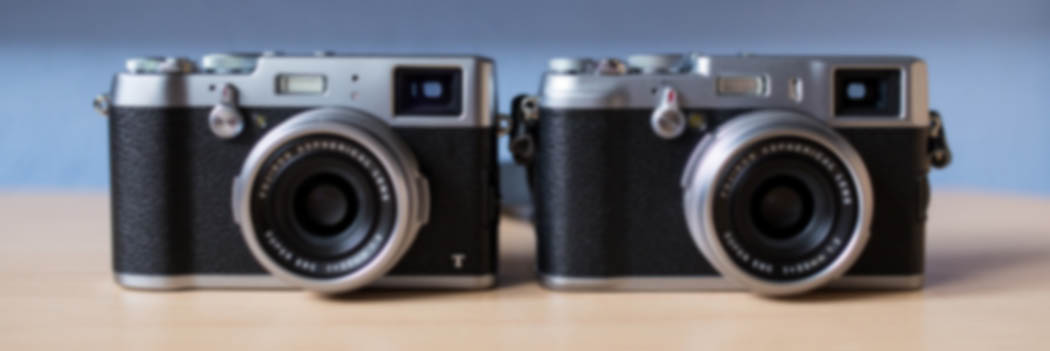This article has been just updated: January 17, 2024
There’s something truly magical about cameras with optical viewfinders. When you see the world as it really is, instead of as a bunch of tiny pixels, you notice even the smallest details and can better appreciate the beauty of nature.
The Fujifilm X100 is the world’s first combined optical and electronic viewfinder camera, and it’s still as relevant today as it was when it was first released, especially because Fujifilm has released several improved versions since then.
Fujifilm X100 + X100F + X100T Review
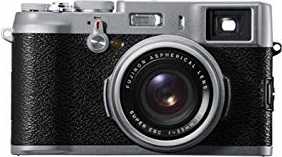
Instead of reviewing each Fujifilm X camera separately, we’ve decided to compare them and summarize their strengths and weaknesses. When Fujifilm X100 was released, it was described as a revolutionary camera because of its optical viewfinder with the ability to display captured images along with all the essential camera information you may be used to from DSLRs.
Key features
The Fujifilm X100 has an SLR-size APS-C sensor and traditional analog control dials, hiding modern technology behind an appealing retro façade. The sensor has a resolution of 12 MP, and the camera comes with a fixed prime lens with a focal length of 35 mm.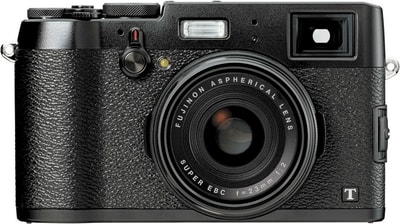
The Fujifilm X100T features an APS-C size X-Trans CMOS II sensor, which provides better low-light performance and 16.3 million effective pixels.
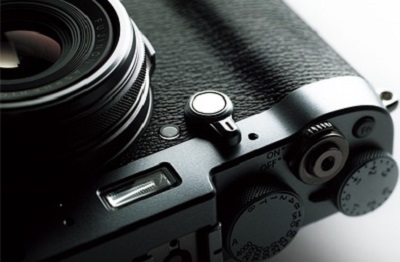
The newest member of the Fujifilm X family is the X100F, which comes with an APS-C size X-Trans CMOS III sensor and has 24 MP. It can record HD video footage and simulate analog film to offer smooth gradation, deep blacks, and beautiful textures without any post-processing.
The Fujifilm X100F also has a significantly improved electronic viewfinder, making it an easy choice for those who can afford it.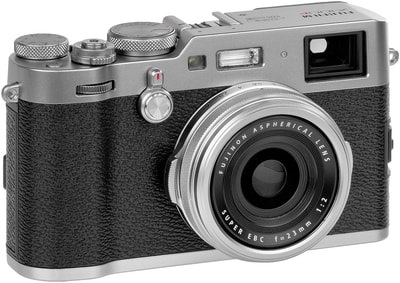
Regardless of which Fujifilm X camera you choose, you’ll be able to take stunning pictures without hauling a heavy DSLR camera or fighting with awkward smartphone camera controls.
Pros: Gorgeous retro design. Optical viewfinder. Easy to use. Lightweight and portable. Great low-light performance.
Cons: The original X100 has been discontinued, and its successors are expensive.
Top 7 Best Alternatives to Fujifilm X100
1. Sony RX1
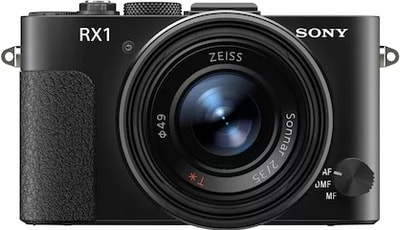 The image sensor inside your Android or iOS smartphone measures just a few millimeters. The image sensor inside the Sony RX1 measures 35 mm, which is the same size as 35 mm format film. In fact, the RX1 is the world’s first compact digital camera with a 35 mm full-frame sensor, producing results that were not possible to achieve without a large DSLR camera not too long ago. The only problem is that you have to pay $2,399 to enjoy a full-frame sensor in a compact camera body. If you can justify the steep price, we guarantee the RX1 from Sony will serve you well.
The image sensor inside your Android or iOS smartphone measures just a few millimeters. The image sensor inside the Sony RX1 measures 35 mm, which is the same size as 35 mm format film. In fact, the RX1 is the world’s first compact digital camera with a 35 mm full-frame sensor, producing results that were not possible to achieve without a large DSLR camera not too long ago. The only problem is that you have to pay $2,399 to enjoy a full-frame sensor in a compact camera body. If you can justify the steep price, we guarantee the RX1 from Sony will serve you well.
Pros: Full-frame sensor. Compact camera body. Extremely fast and reliable autofocus. Suitable for professional use.
Cons: Expensive. Comes only with a fixed-length lens.
2. Olympus E-M10 II
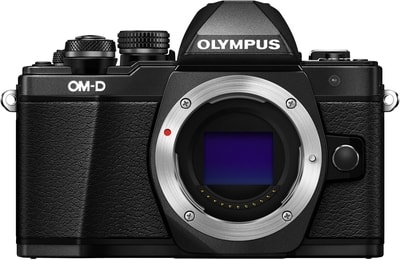 The Olympus E-M10 II is a likable companion for photographers that don’t know what the word compromise means. It’s small, lightweight, has Wi-Fi connectivity, interchangeable lenses, and optical image stabilization. Its Micro Four Thirds sensor has a resolution of 16 MP, and the camera is protected against dust and water splashes. We like that its possible to tilt the 3-inch LCD display on the back of the camera for over-the-head or ground shots, but you can also compose pictures using the built-in electronic viewfinder.
The Olympus E-M10 II is a likable companion for photographers that don’t know what the word compromise means. It’s small, lightweight, has Wi-Fi connectivity, interchangeable lenses, and optical image stabilization. Its Micro Four Thirds sensor has a resolution of 16 MP, and the camera is protected against dust and water splashes. We like that its possible to tilt the 3-inch LCD display on the back of the camera for over-the-head or ground shots, but you can also compose pictures using the built-in electronic viewfinder.
Pros: High-quality sensor with great color reproduction. Built-in optical image stabilization. Interchangeable lenses.
Cons: The shutter mechanism could be quieter, but it’s still much better than the sound DSLR cameras make.
3. Canon G1 X III
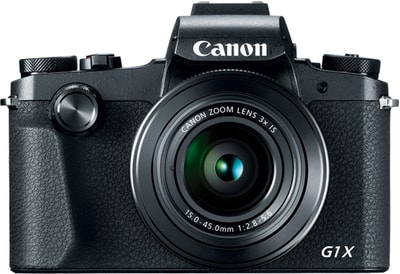
Not everyone is keen on spending hundreds and thousands of dollars on interchangeable lenses just to dabble in multiple photography genres. The Canon G1 X III comes with a versatile zoom lens whose quality matches that of many DSLR lenses. With a range of 24–72 mm, the lens lets you capture both wide-angle shots of nature and events as well as portraits and pictures of animals. Thanks to the DIGIC 7 image processor, low-light photography is more than possible, and the camera’s reliable autofocus works even when light is limited.
Pros: Large image sensor with fantastic low-light performance. Versatile zoom lens. Comfortable grip.
Cons: Sub-par battery life. Can’t record 4K video.
4. Panasonic Lumix DMC-LX100
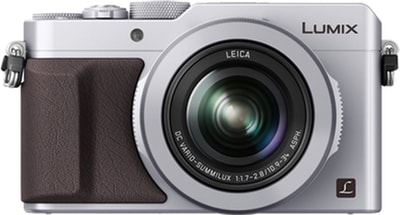 The Panasonic Lumix DMC-LX100 is a premium compact camera with the ability to record 4K video at 30 or 24 frames per second. The camera can extract high-resolution 8MP images from the recorded video. Its lens has a focal length of 24 to 75 mm and f/1.7-2.8, allowing you to create a stunning Bokeh effect when shooting portraits or close-ups.
The Panasonic Lumix DMC-LX100 is a premium compact camera with the ability to record 4K video at 30 or 24 frames per second. The camera can extract high-resolution 8MP images from the recorded video. Its lens has a focal length of 24 to 75 mm and f/1.7-2.8, allowing you to create a stunning Bokeh effect when shooting portraits or close-ups.
Pros: Built-in Wi-Fi connectivity for easy photo transfer. Electronic viewfinder that makes it easier to compose shots when facing the sun.
Cons: Low battery life. Screen doesn’t tilt nor supports touch.
5. Fujifilm X-E3
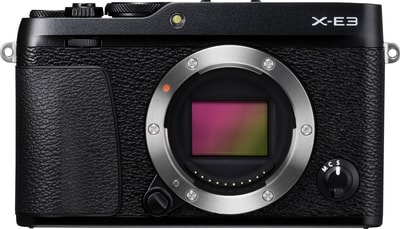 The Fujifilm X-E3 is a compact camera with interchangeable lens for photographers who believe in minimalism. It delivers best-in-class performance in a compact package and provides direct access to the most often used settings. The camera feels great in hands, and its touchscreen LCD lets you pick a focus point with your finger. You can connect the Fujifilm X-E3 to your computer, smartphone, or tablet via Bluetooth to transfer pictures and videos wirelessly.
The Fujifilm X-E3 is a compact camera with interchangeable lens for photographers who believe in minimalism. It delivers best-in-class performance in a compact package and provides direct access to the most often used settings. The camera feels great in hands, and its touchscreen LCD lets you pick a focus point with your finger. You can connect the Fujifilm X-E3 to your computer, smartphone, or tablet via Bluetooth to transfer pictures and videos wirelessly.
Pros: Impressive image quality delivered in a compact package. Touchscreen LCD. Interchangeable lenses.
Cons: No dedicated ISO dial.
6. Panasonic ZS100
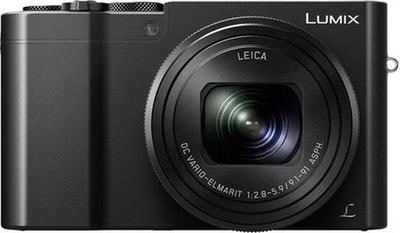 If you want a stylish compact camera with a large image sensor and an extremely versatile zoom lens, you can’t do much better than the Panasonic ZS100. This modern compact camera has a lens-mounted control ring that brings DSLR-like exposure control to the compact point-and-shoot market segment, giving you all the precision you need to compose shots without any delay. The camera can record 4K video and bring you closer to your subject with its 10x zoom.
If you want a stylish compact camera with a large image sensor and an extremely versatile zoom lens, you can’t do much better than the Panasonic ZS100. This modern compact camera has a lens-mounted control ring that brings DSLR-like exposure control to the compact point-and-shoot market segment, giving you all the precision you need to compose shots without any delay. The camera can record 4K video and bring you closer to your subject with its 10x zoom.
Pros: 10x optical zoom in a compact body. Built-in Wi-Fi connectivity. 4K video recording capabilities.
Cons: LCD screen doesn’t tilt.
7. Canon G5 X
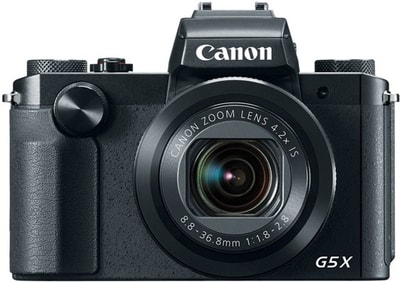 There’s a middle ground between compact cameras for amateur photographers and professional DSLRs: the Canon G5 X. This prosumer G-Series camera has a brilliant 1.0-inch 20.2 MP high-sensitivity CMOS sensor that’s larger than the sensors in most compact cameras, and it uses Canon’s HS SYSTEM to let you take beautiful low-light shots with minimal noise and impressive detail.
There’s a middle ground between compact cameras for amateur photographers and professional DSLRs: the Canon G5 X. This prosumer G-Series camera has a brilliant 1.0-inch 20.2 MP high-sensitivity CMOS sensor that’s larger than the sensors in most compact cameras, and it uses Canon’s HS SYSTEM to let you take beautiful low-light shots with minimal noise and impressive detail.
Pros: Excellent photo and video quality at an affordable price. DSLR-like controls without DSLR-like bulk.
Cons: Doesn’t record 4K video.
Conclusion
The Fujifilm X series of compact cameras is easy to recommend to all avid photographers who want to take stunning pictures and look discrete while doing so. As revolutionary as the original Fujifilm X100 was when it was first released, there are now many other similar compact cameras with large sensors and professional features on the market, so amateur and professional photographers alike have much more options.
FAQ
What are the key features of the Fujifilm X100 series?
The Fujifilm X100 series is renowned for its retro design, hybrid viewfinder, and fixed 23mm f/2 lens, which translates into a 35mm equivalent on a full-frame camera. It boasts an APS-C sensor, intuitive manual controls, and classic film simulation modes typical of Fujifilm’s imaging heritage.
How did the Fujifilm X100F improve upon the previous models?
The Fujifilm X100F introduced a significant upgrade in sensor resolution, with a 24.3MP X-Trans CMOS III sensor, an improved autofocus system, enhanced battery life, and more practical control layouts, including a focus joystick.
What is the distinction between the X100T and the X100F?
The X100T precedes the X100F and features a 16.3MP X-Trans CMOS II sensor versus the 24.3MP in the X100F. Additionally, the X100F has a larger battery, faster image processing, and a more refined user interface.
Can you change the lens on the Fujifilm X100 series?
No, the lens on the Fujifilm X100 series is fixed and cannot be changed. However, there are wide-angle and teleconverter lenses available that can be attached to modify the focal length.
What is the approximate battery life for the X100F?
The battery life for the X100F is rated at approximately 390 shots per charge, but real-life usage may vary based on your settings and shooting habits.
How do film simulation modes enhance the X100 series’ image quality?
Film simulation modes replicate the look of classic Fujifilm film stocks, providing unique color profiles and effects that enhance the image quality with a distinctive aesthetic, directly from the camera.
Are the X100 series cameras suitable for professional photography?
Yes, the X100 series can be used for professional photography, especially in genres like street, travel, or documentary photography where a compact and efficient camera offers an advantage.
What makes the hybrid viewfinder in the X100 series unique?
The hybrid viewfinder in the X100 series can switch between an optical viewfinder (OVF), which provides a clear, unaltered view of your subject, and an electronic viewfinder (EVF), which displays a digital preview of your image with live exposure settings.
Is the Fujifilm X100 series weather-sealed?
Neither the Fujifilm X100, X100T, nor X100F are weather-sealed, so they are not officially protected against the elements like some other camera models in the market.
What are some direct competitors to the Fujifilm X100 series?
Notable competitors include the Leica Q2, Ricoh GR III, Sony RX1R II, and Canon PowerShot G1 X Mark III, offering a similar compact size with high-quality fixed lenses.
What is the maximum video resolution of the X100F?
The X100F can shoot video at a maximum resolution of 1080p at 60fps.
Does the X100 series offer image stabilization?
No, the X100 series does not have in-built image stabilization, so users need to rely on steady hands or other forms of stabilization when shooting in low light or at slow shutter speeds.
Is it possible to use an external flash with the Fujifilm X100 series?
Yes, you can attach an external flash to the X100 series cameras via the hot shoe or use off-camera flashes with wireless triggering.
What wireless connectivity options are available in the X100F?
The X100F features Wi-Fi connectivity which allows for remote control of the camera and wireless image transfer to smartphones or tablets using Fujifilm’s dedicated app.
Are there any major improvements in autofocus speed across the X100 series?
Yes, each new iteration in the X100 series has seen improvements in autofocus speed and accuracy, with the X100F being the fastest amongst its predecessors.
Is the Fujifilm X100 series compatible with third-party lenses or accessories?
While the lens is not interchangeable, third-party accessories like lens hoods, thumb grips, and conversion lenses are available for the X100 series.
What types of storage media are supported by the Fujifilm X100 series?
The X100 series supports SD/SDHC/SDXC memory cards for storage, giving users plenty of flexibility with regard to storage capacity.
How does the X100 series manage low light photography?
The X100 series performs reasonably well in low light due to its large APS-C sensor and fast f/2 lens, coupled with the high ISO performance typical of Fujifilm cameras.
Can you manually focus with the Fujifilm X100 series?
Yes, the Fujifilm X100 series provides full manual focus capability with focus peaking and digital split image aids to assist in pinpointing focus accuracy.
Are there any notable third-party reviews for the Fujifilm X100 series?
Several photography-focused websites and online magazines have in-depth reviews of the Fujifilm X100 series. A notable source is DPReview, which offers detailed analyses and comparisons with other cameras.


